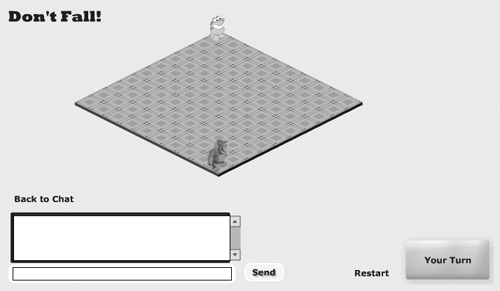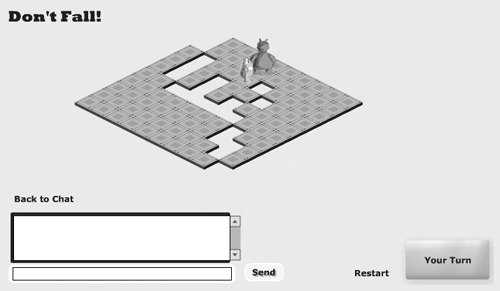Game Overview
| Don't Fall! is a very simple but fun game. It uses an isometric tile-based world as the game board. As far as multiplayer games go, there is very little going on at once, and there isn't much opportunity for synchronization issues. This game is just waiting for someone to customize it, to make it more interesting (stay tuned at the end of the chapter for some ideas on this). Before launching into the rules, let me lay out the basic setup of the game. There are two characters, one for each of the two players. Each of the characters is a monster one green, one blue. The fact that the characters are monsters lends to the theme of the game but changes nothing about the game play itself of course they could be any sort of characters you want. The world is a tile-based, isometric, 10-by-10 grid. The grid's size does not play that important a role, either; changing the grid size should not affect game play much. For the sake of explanation, let's assume that Player 1 is always the green monster, and Player 2 is always the blue monster.
Here are the rules of this game:
From the rules you should be able to guess that the object of the game is to stay standing longer than your opponent. The steps you choose to take can force your opponent into taking steps where he doesn't want to go. This game can become addictive. You will start to see that there is some strategy involved.
At this point you will find that both game instances have moved to a screen that displays the game of Don't Fall! The green monster is Player 1. So move to the game instance that belongs to the green monster. As you move your mouse over the tiles, you'll notice that a little circle appears if your mouse moves over any tiles that are adjacent to the one on which the green monster stands. You can then click any of those tiles. Once you click, the green monster walks to that tile, and the tile he was just on falls. It is now the blue monster's turn. Move to the game instance belonging to him. You should immediately see that this game instance shows exactly what the other one does the green monster in a new spot and one tile missing. You can now click a tile adjacent to the blue monster to move him. Keep moving both monsters until someone wins. And there you have it a simple but addictive game.
For the rest of the chapter, we will discuss the multiplayer ActionScript, the game ActionScript, and some possible game improvements for Don't Fall! |
EAN: N/A
Pages: 163


